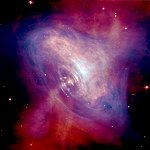A supernova is a center of knowledge about how a dead star distributes the materials that eventually find their way into new stars, elements from which we are also composed
22.9.2002
By: Avi Blizovsky

Astronomers recently got a deeper and closer look than ever before at the remnants of a supernova, where an old star exploded and then collapsed in on itself. The new images will help scientists learn what happens after the supernova event, thereby refining the theories about the life cycle of the stars and how supernovae help recycle the matter in the universe.
Only in astronomy can something that has exploded and collapsed still be a dynamic and energetic body. Scientists are now studying the remnants of supernovae - those stars that have run out of nuclear fuel.
A supernova is one of nature's most spectacular sights. Any supernova can be as bright as an entire galaxy of billions of stars when it explodes. It immediately enters a rapid spin and becomes a neutron star so compressed that no material can escape from it. However, contrary to that, afterwards, long after the explosion, the place looked different and quiet. This is according to the observations accumulated on most of the 231 known supernova remnants in the Milky Way.
However, astronomers using the X-ray Chandra Satellite Observatory and the Hubble Space Telescope found completely different things. In particular, this is one of the most well-known supernovae - the Cancer Nebula. This is the gas cloud surrounding the remnants of a supernova whose explosion echoes reached the eyes of Chinese astronomers in 1054. It was so bright that it was clearly visible even in the daytime. Now it has been revealed for the first time that the core of the supernova is buzzing with jets and bursts of energy, almost a thousand years after the explosion (of course, as it is visible to our eyes when the images reach us at the speed of light.
Physicist Victoria Caspi, of McGill University in Montreal, Canada, says that researchers are now eager to take a deeper look at similar nebulae to see if they too are dynamic.
"Since all the others appear formless and static, the theoretical models developed based on the observations to understand the physics of these objects have estimated that they are static and narrowly retain a spherical shape." she said. "From Chanadra's new data, it is clear that these theories need updating to incorporate the new data into the model."
Astronomers from the University of Pennsylvania and Arizona State University combined images of the Cancer Nebula taken by Chandra with visible light images taken by the Hubble Space Telescope and turned it into a motion picture, illustrating that the nebula is sizzling.
Bright waves of electrons and anti-electrons (positrons) move forward at half the speed of light, forming a spreading ring like a ripple in a lake. It seems that the origin of these waves is in the material that was deflected by the rotational force of the pulsating neutron star - also known as a pulsar. The ring contains over twenty knots that brighten, fade, vibrate and disappear and burst frequently to give impetus to the spreading particle clouds.
Physicist Geoffrey Hester of Arizona State University says the film brought the cancer nebula to life. "The amazing thing here is that we are beginning to see in front of our eyes what is happening in an expanding and exploding environment, an environment that is unparalleled in our day-to-day lives. However, this environment can be found in the vicinity of pulsars, around black holes, in the cores of quasars. This is a unique look at the physics that takes place under such conditions." said.
Although the nebula itself may seem exotic, however, Professor Robert Kirchner from Harvard University says that, despite this, it allows us to understand how the universe works. It is a center of knowledge about how a dead star distributes the materials that eventually find their way to new stars, ingredients from which we are also composed.
